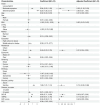Association of Patient-Reported Outcome Patterns and Major Clinical Factors with Frailty in Stable COPD
- PMID: 40529222
- PMCID: PMC12170799
- DOI: 10.2147/COPD.S517270
Association of Patient-Reported Outcome Patterns and Major Clinical Factors with Frailty in Stable COPD
Abstract
Purpose: Chronic obstructive pulmonary disease (COPD) exhibits heterogeneous symptom profiles across individuals. This study aimed to identify subgroups of patients with stable COPD according to physiological, psychological, and environmental symptoms; assess differences in their characteristics; and examine the association of symptom patterns with frailty.
Patients and methods: We analyzed data from the second wave of a cohort study involving patients with COPD reassessed 6 months after hospitalization for acute exacerbations. Frailty and patient-reported outcomes were measured using the FRAIL and Modified COPD-Patient-Reported Outcome (mCOPD-PRO) scales. Latent profile analysis identified subgroups based on mCOPD-PRO symptom patterns. Differences across symptom severity subgroups were assessed using post-hoc trend analyses and chi-square tests for trends. Multinomial logistic regression quantified the magnitude of differences between subgroups. The relationship between subgroups, clinical factors, and frailty was examined through linear regression.
Results: Among 308 patients with stable COPD, three subgroups were identified: "low-symptom" (27.9%), "moderate-symptom" (51.3%), and "severe-symptom" (20.8%). Body mass index, Global Initiative for Chronic Obstructive Lung Disease stage (GOLD), COPD Assessment Test (CAT) score, modified Medical Research Council (mMRC) score, and physical activity exhibited significant linear trends across subgroups of increasing symptom severity. Frailty scores differed significantly: 0.50 ± 0.78 in the low-symptom group, 1.34 ± 0.96 in the moderate-symptom group, and 2.72 ± 0.95 in the severe-symptom group. Multivariate analysis identified severe-symptom group (β coefficient [β]=0.62, 95% confidence interval [CI]: 0.21-1.03), rural residence (β=0.21, 95% CI: 0.04-0.39), GOLD (β=0.23, 95% CI: 0.07-0.39), mMRC (β=0.17, 95% CI: 0.03-0.31), and CAT score (β=0.04, 95% CI: 0.02-0.06) associated with frailty.
Conclusion: Patients with stable COPD can be categorized based on patient-reported outcomes, with differences in demographic and disease characteristics across subgroups. Patients with severe COPD symptoms revealed higher levels of frailty compared to those with low symptoms.
Keywords: COPD; acute exacerbation; aging; frailty; patient-report outcome.
Plain language summary
Patients with chronic obstructive pulmonary disease (COPD) often experience a variety of symptoms, including physical, psychological, and environmental challenges, which may affect their health status and increase frailty risk. Patient-reported outcomes (PROs) are valuable tools in clinical practice that allow patients to report their symptoms and thus reflect on their health status. However, the relationship between distinct symptom patterns, sociodemographic and disease-related factors, and frailty among patients with stable COPD remains unclear. This study conducted in a large tertiary care institution in Sichuan Province of China, analyzed data from 308 patients with stable COPD who were evaluated six months after discharged from the hospital for acute exacerbations. Frailty was assessed by the FRAIL scale, and symptom patterns were measured through the Modified COPD Patient-Reported Outcome (mCOPD-PRO). Latent profile analysis identified three subgroups: “low-symptom”, “moderate-symptom”, and “severe-symptom”. The results of the study showed that the severe-symptom group had higher levels of frailty compared to the low-symptom group. Furthermore, patients in the severe-symptom group tend to be physically inactive and have poorer health characteristics, such as higher disease severity and symptom burden. These results emphasize the need for early screening and targeted interventions for patients with severe symptoms to mitigate frailty and its associated risks. By identifying symptom patterns and their relationship with frailty, this study highlights the importance of PROs in understanding patient experiences and guiding clinical strategies to improve care for patients with COPD.
© 2025 Yang et al.
Conflict of interest statement
The authors declare that they have no competing interests.
Figures
Similar articles
-
Association of Frailty with Patient-Report Outcomes and Major Clinical Determinants in Patients with Acute Exacerbation of Chronic Obstructive Pulmonary Disease.Int J Chron Obstruct Pulmon Dis. 2024 Apr 12;19:907-919. doi: 10.2147/COPD.S444580. eCollection 2024. Int J Chron Obstruct Pulmon Dis. 2024. PMID: 38628984 Free PMC article.
-
Frailty and Exacerbation of Chronic Obstructive Pulmonary Disease: Is There Any Association?Int J Chron Obstruct Pulmon Dis. 2024 May 24;19:1131-1139. doi: 10.2147/COPD.S455316. eCollection 2024. Int J Chron Obstruct Pulmon Dis. 2024. PMID: 38807967 Free PMC article.
-
Influence of Urinary Incontinence Related Factors on Health-Related Quality of Life in Patients with Chronic Obstructive Pulmonary Disease: A Cross-Sectional Study.Int J Chron Obstruct Pulmon Dis. 2025 Jun 12;20:1881-1892. doi: 10.2147/COPD.S515494. eCollection 2025. Int J Chron Obstruct Pulmon Dis. 2025. PMID: 40529223 Free PMC article.
-
Clinical Efficacy of Mobile App-Based, Self-Directed Pulmonary Rehabilitation for Patients With Chronic Obstructive Pulmonary Disease: Systematic Review and Meta-Analysis.JMIR Mhealth Uhealth. 2024 Jan 4;12:e41753. doi: 10.2196/41753. JMIR Mhealth Uhealth. 2024. PMID: 38179689 Free PMC article.
-
Association between lung function and exacerbation frequency in patients with COPD.Int J Chron Obstruct Pulmon Dis. 2010 Dec 9;5:435-44. doi: 10.2147/COPD.S13826. Int J Chron Obstruct Pulmon Dis. 2010. PMID: 21191438 Free PMC article.
References
-
- Adeloye D, Song P, Zhu Y, Campbell H, Sheikh A, Rudan I. Global, regional, and national prevalence of, and risk factors for, chronic obstructive pulmonary disease (COPD) in 2019: a systematic review and modelling analysis. Lancet Respir Med. 2022;10(5):447–458. doi: 10.1016/S2213-2600(21)00511-7 - DOI - PMC - PubMed
-
- World Health Organization. Chronic obstructive pulmonary disease (COPD). Available from: http://www.who.int/news-room/fact-sheets/detail/chronic-obstructive-pulm.... Accessed April 23, 2024.
MeSH terms
LinkOut - more resources
Full Text Sources
Medical
Miscellaneous



